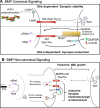Synapse development and maturation at the drosophila neuromuscular junction
- PMID: 32741370
- PMCID: PMC7397595
- DOI: 10.1186/s13064-020-00147-5
Synapse development and maturation at the drosophila neuromuscular junction
Abstract
Synapses are the sites of neuron-to-neuron communication and form the basis of the neural circuits that underlie all animal cognition and behavior. Chemical synapses are specialized asymmetric junctions between a presynaptic neuron and a postsynaptic target that form through a series of diverse cellular and subcellular events under the control of complex signaling networks. Once established, the synapse facilitates neurotransmission by mediating the organization and fusion of synaptic vesicles and must also retain the ability to undergo plastic changes. In recent years, synaptic genes have been implicated in a wide array of neurodevelopmental disorders; the individual and societal burdens imposed by these disorders, as well as the lack of effective therapies, motivates continued work on fundamental synapse biology. The properties and functions of the nervous system are remarkably conserved across animal phyla, and many insights into the synapses of the vertebrate central nervous system have been derived from studies of invertebrate models. A prominent model synapse is the Drosophila melanogaster larval neuromuscular junction, which bears striking similarities to the glutamatergic synapses of the vertebrate brain and spine; further advantages include the simplicity and experimental versatility of the fly, as well as its century-long history as a model organism. Here, we survey findings on the major events in synaptogenesis, including target specification, morphogenesis, and the assembly and maturation of synaptic specializations, with a emphasis on work conducted at the Drosophila neuromuscular junction.
Keywords: Bouton addition; Cell-adhesion molecules; Drosophila melanogaster; Neuromuscular junction; Presynaptic active zone; Synapse; Synaptic plasticity; Trans-synaptic signaling.
Conflict of interest statement
The authors declare that they have no competing interests.
Figures



References
Publication types
MeSH terms
Substances
Grants and funding
LinkOut - more resources
Full Text Sources
Molecular Biology Databases

